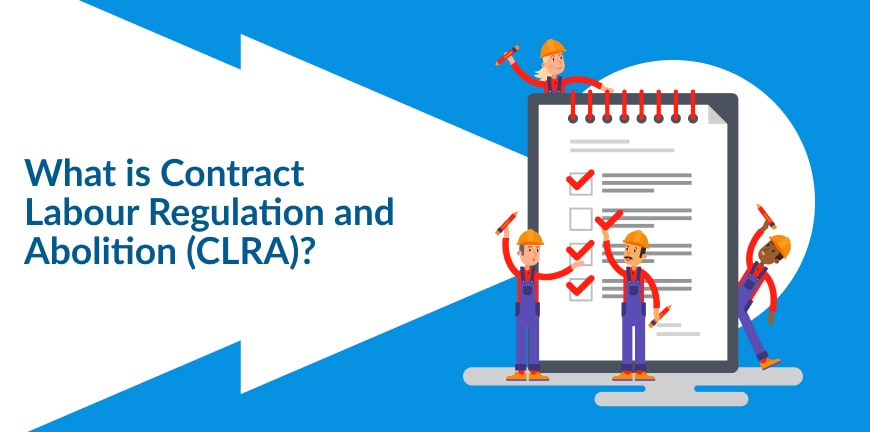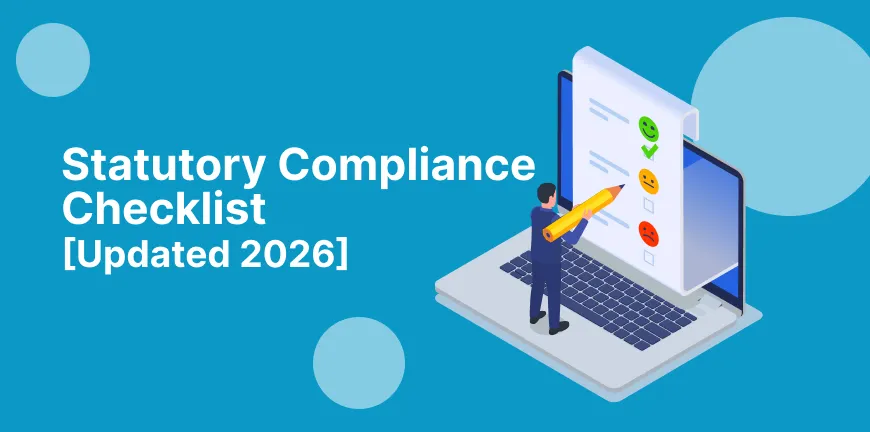
What Is an Employee Management System (EMS)? A Complete Guide
28/04/2025
What Is Regulatory Compliance? Definition, Examples, Insights
28/04/2025- What is CLRA Full Form and Meaning?
- What is the Background of the CLRA Contract Labour Act 1970?
- What are the Key Objectives of the Contract Labour Act?
- What is CLRA Registration and Licensing Requirements?
- What are the Rights and Benefits for Contract Workers?
- What are the Responsibilities of Principal Employers
- What are the Penalties for Non-Compliance under the Contract Labour Act 1970?
- What are the Recent Amendments and Changes to CLRA?
- What are the Best Practices for CLRA Compliance?
- Frequently Asked Questions (FAQs)
Contract labourers are in a vulnerable position since they face numerous difficulties like lower wages, lack of job security, low or no medical coverage, harsher working conditions, etc., when compared to permanent employees. To protect the rights and improve the working conditions for contract labour throughout India, the CLRA Act is being implemented, and both employers and contractors must comply; otherwise will face legal trouble and penalties.
Let’s get an in-depth understanding of CLRA full form, meaning, background, objectives, rights, and benefits of contract labourers so that we can use the insights to achieve better compliance and provide a safe working environment for contract workers.
What is CLRA Full Form and Meaning?
CLRA full form is the Contract Labour Regulation and Abolition Act 1970. According to this act, ” The rights and working conditions of contract labourers must be regulated in certain establishments and must be abolished completely in some establishments”. Any violations of non-compliance in the contract labour regulation and abolition act can lead to serious consequences like penalties, lawsuits, and in extreme cases, imprisonment.
What is the Background of the CLRA Contract Labour Act 1970?
The contract labour definition states, “Contract labour is an individual or group of people hired to execute a task for a company or an industry, with a contractor acting as a connecting bridge between the employers and the workers.
In India, contract labour has a long history, and exploitation was very rampant before independence. The British East India Company introduced various labour laws and regulations to regulate the workforce for various labour-intensive activities such as mining, plantation agriculture, railways, and other infrastructure-related projects. Post Independence, the Indian government brought numerous regulations and laws to stop the exploitation of the labour workforce and protect their rights.
The Contract Labour Regulation & Abolition Act 1970 was introduced by the Indian legislature, aimed at regulating the contract labour employed and ensuring their welfare. The act mandates employers who are utilising the services of contract labourers to obtain licences, provide suitable wages and benefits, and maintain safe working conditions.
The Contract Labour Act 1970 applies to both skilled and unskilled labour workforce and spans multiple sectors like factories, mines, construction, plantations, and other labour-intensive industries.
What are the Key Objectives of the Contract Labour Act?
The major objectives and scope of the Contract Labour Regulation and Abolition Act include:
- To prevent and abolish the exploitation of contract labourers.
- Employers and contractors must provide safe working conditions for contract labourers as per the contract labour regulation and abolition rules.
- To regulate the performance and functioning of the advisory committees and boards.
- To frame rules and regulations for employers to register their establishments to allow the employment of contract labourers.
- To state the procedure and other requirements for licensing of contracts
- To provide provisions of penalties in case of violations committed against the Contract Labour Regulation & Abolition Act 1970.
What is CLRA Registration and Licensing Requirements?
CLRA Registration and Licensing are part of the process of establishing compliance of a company against the Contract Labour Regulation & Abolition Act 1970. Both employers and contractors must obtain licences to use contract labour services while operating in India.
Who must obtain a CLRA License?
- Contractors who employ more than 20 contract labourers for themselves or other companies.
- Principal employers who engage with contractors to deploy more than 20 contract labourers to work in their industry premises.
Documenta is necessary for obtaining the CLRA License
For Principal Employers
- Form V – Application form.
- A copy of PAN and Aadhaar.
- Address proof (passport, ration card, bank passbook, railway ID, etc).
- Company registration certificate or Partnership firm deed.
- Proof of registration under the S&E Act (Shops and Establishments Act)
- Contractor details who engaged in the supply or engagement of contract labourers.
For Contractors
- Form VI – Application form.
- A copy of PAN and Aadhaar.
- Address proof (bank passbook, ration card, passport, railway ID, disabled ID, etc).
- Company registration certificate or Partnership company deed.
- An agreement or contract copy between the contractor and the principal employer.
- Registration proof under the S&E Act (Shops and Establishments Act).
- Proof of payment of PF and ESI contributions.
- Security deposit in the form of a bank guarantee or a DD(demand draft).
- Bank statement for the last 6 months.
What are the Rights and Benefits for Contract Workers?
Here are the applicable rights and benefits for contract workers under the Contract Labour Act 1970:
- Fair Wages and Benefits: Under contract labour rules, the workers are entitled to fair wages and benefits that are comparable to employees working full-time.
- Medical and PF: Under the Contract Labour Act 1970, contract workers must receive medical coverage under ESI and provident fund.
- Safe working conditions: As per the contract labour regulation and the abolition act mandate, contract workers must be provided safe working conditions with facilities like a canteen, restrooms, and first aid.
- Grievance resolution: The complaints and feedback provided by contract workers must be taken seriously and resolved with priority without prejudice.
- Prohibition of child labour: Under the contract labour regulation and abolition rules, child labour is prohibited, and violations may lead to imprisonment.
- No discrimination: Contract labourers must not be discriminated against based on gender, religion, or caste.
- Right to work: Contractors are free to choose their line of work, and contractors can’t force them against their will.
What are the Responsibilities of Principal Employers
The key responsibilities of principal employers under the Contract Labour Regulation and Abolition Act:
1. Ensure full wage payment
A principal employer is liable to pay full wages to contract labourers in case the contractor fails to make payments or unpaid balances under contract labour rules.
2. Compliance of Contractors
Principal employers must ensure that contractors provide all the necessary amenities to contract labourers during their working hours under the CLRA Act. If a contractor fails to provide the required facilities like a canteen, drinking water, and restrooms, the principal employer must provide them on his behalf as per compliance requirements.
3. Compliance with labour laws
Principal employers must ensure that contractors are complying with labour laws and regulations related to ESI, PF, and pension.
4. Wage Disbursement Monitoring
Principal employers must monitor the wage disbursement of contract labourers and ensure they get promised payments as per contract, access to payslips, bank statements, and other records.
5. Record Keeping
Principal employers must maintain records related to contract labour services like wages paid, number of labourers, nature of work, etc.
What are the Penalties for Non-Compliance under the Contract Labour Act 1970?
Any violation of the contract labour regulation and abolition rules by the principal employer or the contractor can lead to serious consequences such as fines, penalties, legal cases, and even imprisonment. The punishment for specific violations under the Contract Labour Act 1970 includes:
| Violation | Action under the CLRA Act |
| Deploying contract labour without a valid license | Fine up to Rs. 1000/worker |
| Working conditions are not as per the regulations prescribed under the CLRA | Fine up to Rs. 10000 or imprisonment of 3 months |
| Continued violation after first conviction | Additional fine of Rs. 100 per day |
| General violations | Fine up to Rs. 1000 or 3 months of imprisonment |
What are the Recent Amendments and Changes to CLRA?
Contract Labour Regulation and Abolition Act 1970 has undergone numerous changes and amendments over the years. The latest amendments are focused mainly on reducing administrative burdens. The key updates include:
- Simplification of CLRA registration process: The state governments have put efforts into streamlining the CLRA registration process for establishments and contractors to ensure more transparency and efficiency.
- Increased penalties: The government has increased the fines and penalties for violations committed under the CLRA Act to provide more protection for contract labourers and safeguard them against exploitation.
- Expansion of Coverage: The government has expanded the sectors and industries that will come under the Contract Labour Act 1970 to cover a wider pool of contract labourers.
What are the Best Practices for CLRA Compliance?
Here are the best practices for CLRA compliance:
1. Partner with reputable contractors
Companies that are seeking contract labour services must ensure they partner with reputable contractors with clean compliance records. A thorough background check of the contractor’s history, previous compliance records, and references of companies served must be carried out diligently to arrive at the right choice of the contractor.
2. Create a comprehensive contractual agreement
Companies must draft a detailed contractual agreement that defines the roles and responsibilities of contractors, wage disbursement clauses, welfare measures, and conflict resolution. This agreement must be reviewed periodically and modified according to the latest labour laws.
3. Ensure Compliance with basic facilities
Principal employers must ensure contract labourers receive similar amenities, like a canteen, drinking water, restrooms, and a first aid facility similar to permanent employees. Conduct regular inspections and verify that welfare measures are maintained, and if gaps are found, fix them as a priority.
4. Conduct regular audits
Companies must conduct periodic audits of contractors’ compliance practices, such as full wage payment, records of payments are correctly maintained, amenities are as per standards, etc. This will prevent non-compliance and help create a better working environment for contract labourers.
5. Avoid using contract labour for core activities
It is always advised to use contract labour for only non-core activities like maintenance, housekeeping, security, etc. This will minimize legal exposure and conflicts between permanent employees and contract workers.
6. Maintain accurate records
Documentation is key for any organisation to prove compliance with authorities. Companies should use digital platforms to record contract labour data and review it from time to time to ensure the contractor is complying with legal requirements under the contract labour regulation and abolition rules.
Frequently Asked Questions (FAQs)
1. What is the full form of CLRA?
CLRA full form is the Contract Labour (Regulation & Abolition) Act, 1970, and applies to all contract labourers across all states in India.
2. Who is considered a contract labourer under the CLRA Act?
Contract labour definition under the Contract Labour Act 1970 states that ” any individual who is hired by a contractor for a short term to perform different tasks at the workplace of the principal employer for a fixed wage.
3. What is the difference between contract labour and regular employees?
Contract labour is typically hired by contractors to work for an employer on a fixed-term basis with a fixed wage. The responsibility of wage disbursal and maintaining compliance with labour laws lies with the contractor. On the other hand, a permanent employee is hired by a company directly on a long-term commitment with benefits like medical insurance, EPF, increment, etc.
4. What is CLRA compliance in HR?
CLRA compliance in HR means that companies that avail of the services of contract labour must comply with regulations and laws as per the Contract Labour Regulation and Abolition Act. If any compliance issues arise during audits, companies must fix them as a priority to prevent legal problems and penalties.
5. What is the purpose of the CLRA Act, 1970?
The purpose of the Contract Labour Act 1970 is to regulate contract labour employment to safeguard the rights and benefits of individuals working as contract employees under a principal employer or a contractor.
Contact Us For Business Enquiry

Hariharan Iyer
Hariharan Iyer is the Vice President – Operations at ALP Consulting, bringing over 40+ years of experience in HR outsourcing and labour law compliance. He leads end-to-end HRO operations, ensuring process efficiency, statutory compliance, and seamless service delivery for clients across industries. With a strong background in labour law governance and workforce management, Hariharan plays a key role in driving operational excellence and compliance-led HR solutions at ALP Consulting.




